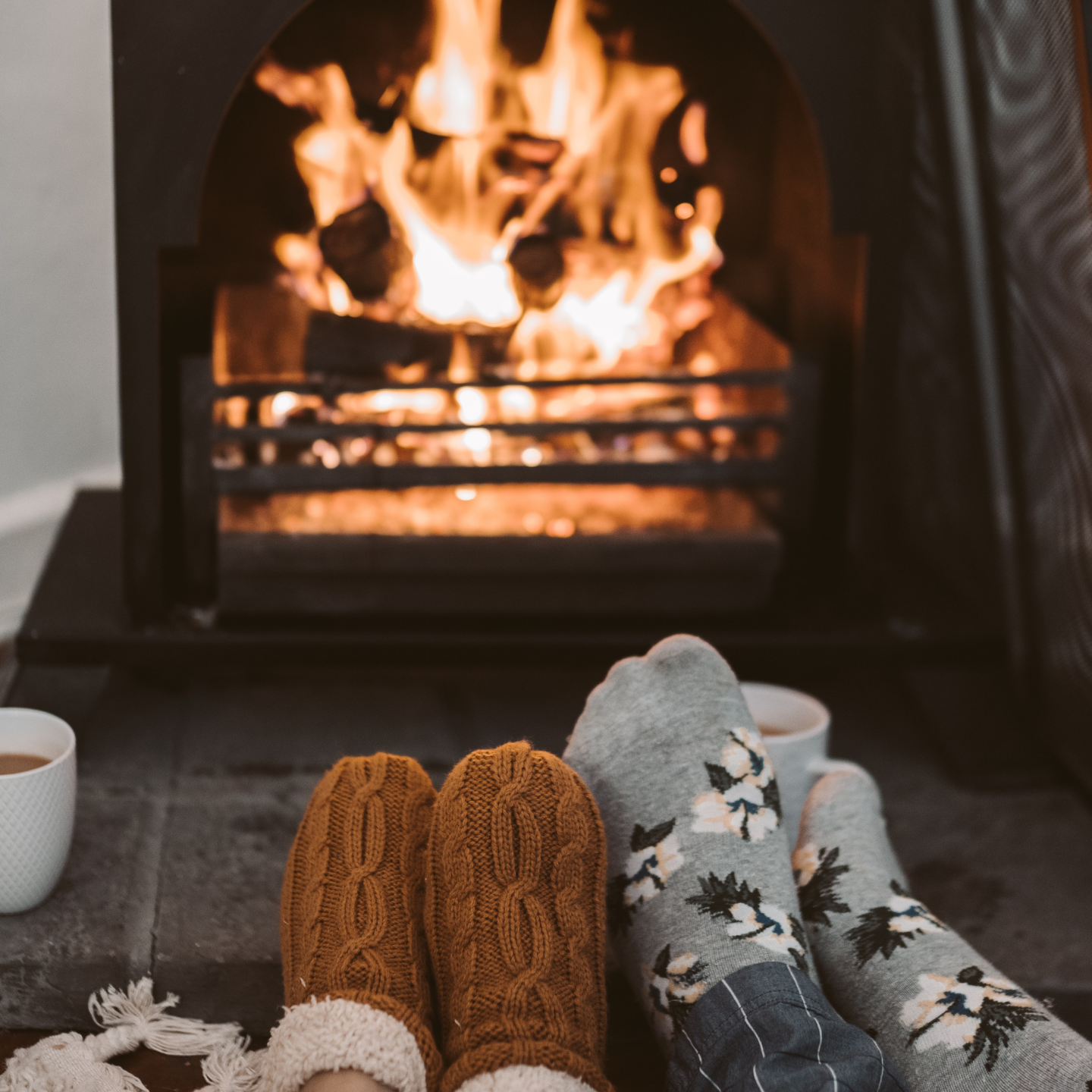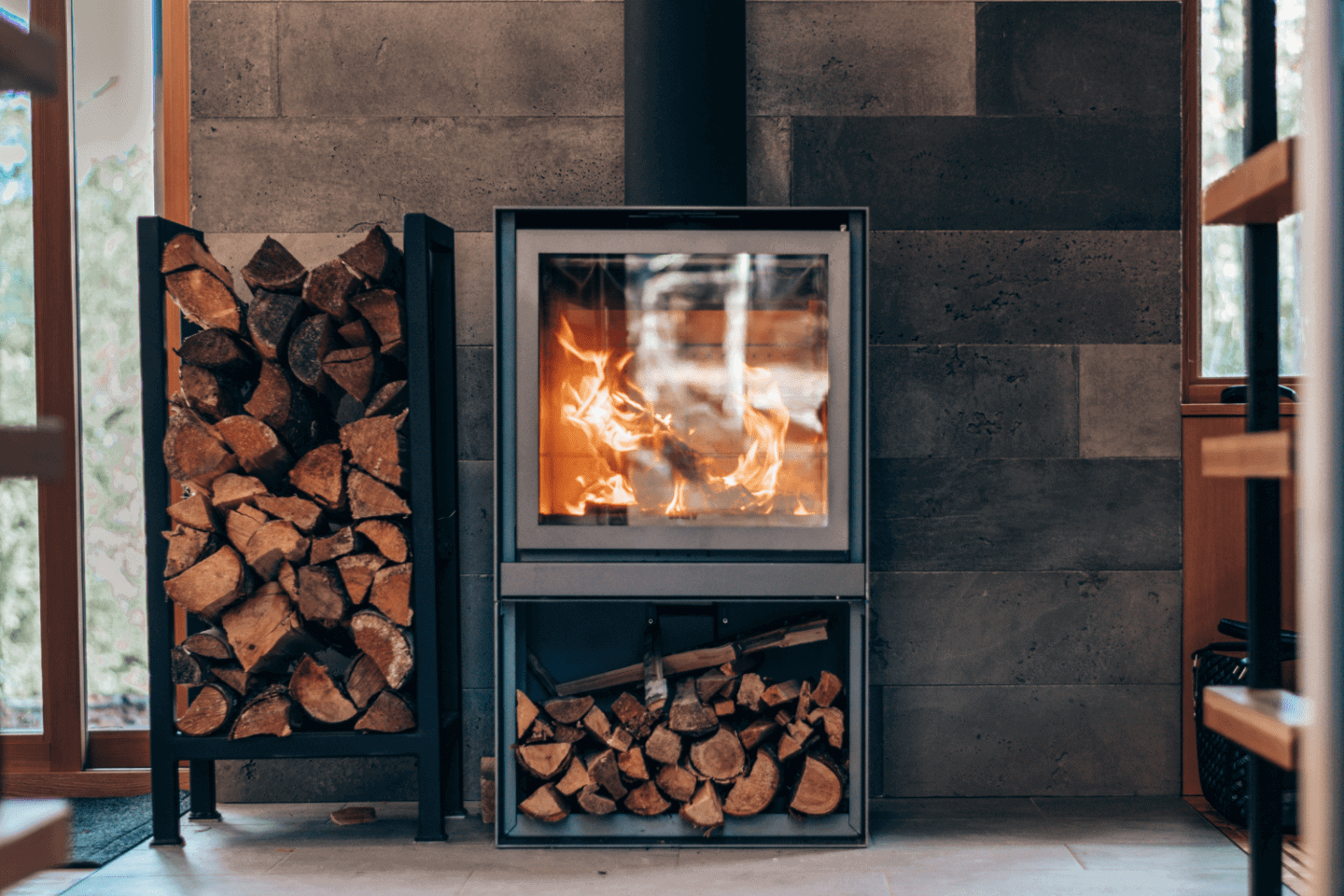Whether you’re taking a weekend trip or spending an entire week in the woods, you want your cabin to be as cozy as possible. If you’re off-grid, that means a cabin fireplace or wood stove is a necessity. But even if your cabin is on the grid, a fireplace can add a sense of warmth and ambiance.
Here’s a quick and easy guide to cabin fireplaces and how to take care of them.

Factors to Consider
Before you choose a fireplace for your cabin, here are a few things you should consider:
- Are you looking for atmosphere alone, or do you need your stove to burn all night and provide heat?
- How big is the area you need to heat?
- Do you need a cooking surface?
- How much firewood is available?
- How much are you concerned about your fire’s environmental impact?
For tips on stacking firewood, check out my article on How To Stack Firewood Off The Ground.
Now that you’ve answered those questions, it’s time to choose a fireplace style.
Cabin Fireplace Styles
Built-in Fireplaces
A built-in fireplace is exactly what it sounds like: a fireplace that’s built into your wall. These are generally only viable if you’re building a new cabin or doing a full remodel since you have to knock out a wall for installation. There are many different styles, from rustic stone to brick to a more modern metallic design.
An excellent example of a built-in metallic fireplace is the Napoleon NZ5000-T High Country 5000. This is a large, open fireplace that provides a full view of the fire and excellent heat dispersal. But if you prefer something more outdoorsy, a simple stone build is OK. Just make sure to have it professionally installed so you know it’s properly built.
Fireplace Inserts
A fireplace insert is used to upgrade or overhaul an existing wood fireplace. If you already have an opening and a chimney, install a new chimney pipe and slide the insert into place.
In most cases, people opt for this option because inserts are more modern and efficient than their old brick or stone fireplace. A good example of this is the Osburn 3500. It has an EPA efficiency rating of 77 percent, which is quite good. It also has a built-in blower that distributes hot air around your cabin.
Freestanding Wood Stoves
A freestanding wood stove has a different set of benefits and drawbacks. On the plus side, you can use it for cooking and heat and atmosphere. On the downside, it will take up more room inside your cabin. This could be a concern in a smaller space, but then again, if you’re off-grid, you really need that cooking surface.
The La Nordica Milly Wood Burning Cook Stove is an excellent example of a freestanding stove. In addition to two burners, it has a built-in oven and a pair of warming chambers next to the chimney.
Gas Fireplaces
A gas fireplace is an entirely different animal than a wood fireplace. For one thing, you don’t need a full chimney, just a vent through the wall or the roof. For another thing, natural gas burns a lot cleaner than wood, and you don’t have to clean up any ash. Most gas fireplaces also come with a thermostat, so you’ll have better control over your cabin’s temperature.
That said, many people prefer the smell of wood smoke, as well as the crackle of a wood fire. You’ll also need to have natural gas available or run one off of a liquid petroleum tank with a gas stove.

Cabin Fireplace Safety
Since you’re dealing with fire, safety is an essential consideration with any fireplace. To keep your cabin fireplace safe, you need to burn the right kind of wood and keep your fireplace clean. You also want to have your fireplace checked professionally once per year. Here are some quick tips.
Prevent Chimney Buildup
There’s an old saying that an ounce of prevention is worth a pound of cure. In the case of chimneys, this means preventing creosote and other flammable chemicals from building up inside your chimney. To do this:
- Burn only hardwoods such as oak, hickory, maple, cherry, or ash. Softer woods like pine or cedar will give off a ton of fumes, and they’ll dirty up your chimney in a hurry.
- Burn only dry wood. Even if it’s a hardwood, wet wood will give off a lot more smoke, which will accumulate in your chimney. If you’re cutting your own firewood, this means keeping it covered – and well-ventilated – for at least six months before putting it into your fireplace.
Keep Your Fireplace Clean
As you use your fireplace, ash will accumulate in the bottom. A little ash can actually be a good thing since it fills up space. But when too much ash builds up, it will restrict airflow. Sooner or later, it’s going to need to be emptied safely. Here are a few pointers:
- Wait a few days before emptying your ash. This will ensure that any coals or embers have entirely burnt out. If this isn’t practical, since you need your fireplace for heat, dig a hole and bury your ashes. Don’t trust to snow or rain to keep them safe. Even a tiny ember can end up sparking a fire.
- Use a metal shovel and bucket. The ashes may be hot, and the last thing you want is melted plastic all over your cabin.
- Keep small children away from ashes. They might decide to play in the ashes, which could have disastrous results.
Have Your Chimney Cleaned Annually
Unless you’re a professional chimney sweep, you probably don’t have the right skills – or tools – to clean your chimney properly. It’s a good idea to have one come out once a year, preferably in spring, to clean your chimney out.
Chimney cleanings generally aren’t expensive, and you can end up getting more than you bargained for. While they’re on-site, a chimney sweep will also perform an inspection and notify you of any structural issues.
Feeling cabin fever this winter? These two articles can help:

Leave a Reply